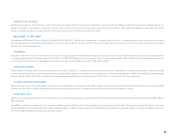Airtran 2005 Annual Report Download - page 41
Download and view the complete annual report
Please find page 41 of the 2005 Airtran annual report below. You can navigate through the pages in the report by either clicking on the pages listed below, or by using the keyword search tool below to find specific information within the annual report.
: : 9. COMMON STOCK : :
We have one class of common stock. Holders of shares of common stock are entitled to one vote per share. At December 31, 2005, 6,796,617 shares of common stock are reserved for future issuance upon exercise
of stock options.
On October 1, 2003, we completed a public offering of 9,116,000 shares of Holdings’ common stock at a price of $16.00 per share, raising net proceeds of approximately $139.2 million, after deducting discounts and
commissions paid to the underwriters and other expenses incurred with the offering.
On October 1, 2003, we used $11.7 million of the proceeds of the public offering of Holdings’ common stock to purchase from an aircraft manufacturer affiliate warrants held by it to purchase 1.0 million shares of
Holdings’ common stock based on the public offering price of the stock of $16.00 less the exercise price of the warrants.
Additionally, we have outstanding detachable warrants issued in March 2001, to an aircraft manufacturer affiliate for the purchase of one million shares of our common stock at $4.51 per share. The warrants had
an estimated value of $4.5 million when issued and expire five years after issuance.
: : 10. STOCK OPTION PLANS : :
Our 1993 Incentive Stock Option Plan provides for the grant of options to officers, directors and key employees to purchase up to 4.8 million shares of common stock at prices not less than the fair value of the shares
on the dates of grant. With respect to individuals owning more than 10 percent of the voting power of all classes of our common stock, the exercise price per share shall not be less than 110 percent of the fair value
of the shares on the date of grant. Our 2002 Long-term Incentive Plan, 1996 Stock Option Plan and 1994 Stock Option Plan provide up to 5 million, 5 million and 4 million incentive stock options or nonqualified
options, respectively, to be granted to our officers, directors, key employees and consultants.
In connection with the acquisition of Airways Corporation in 1997, we assumed the Airways Corporation 1995 Stock Option Plan (Airways Plan) and the Airways Corporation 1995 Director Stock Option Plan (Airways
DSOP). Under the Airways Plan, up to 1.2 million incentive stock options or nonqualified options may be granted to our officers, directors, key employees or consultants. Under the Airways DSOP, up to 150,000
nonqualified options may be granted to directors.
Vesting and term of all options is determined by the Board of Directors and may vary by optionee; however, the term may be no longer than 10 years from the date of grant.
Pro forma information regarding net income and earnings per common share is required by SFAS 123, which also requires that the information be determined as if we had accounted for our employee stock options
granted subsequent to December 31,1994, under the fair value method of that statement. The fair value for these options was estimated at the date of grant using the Black-Scholes option pricing model with the
following weighted-average assumptions for 2004 and 2003, respectively: risk-free interest rates of 3.74 percent and 3.05 percent; no dividend yields; volatility factors of the expected market price of our common
stock of 0.625 and 0.630; and a weighted-average expected life of the options of five years.
The Black-Scholes option valuation model was developed for use in estimating the fair value of traded options that have no vesting restrictions and are fully transferable. In addition, option valuation models require
the input of highly subjective assumptions including the expected stock price volatility. Because our employee stock options have characteristics significantly different from those of traded options, and because
changes in the subjective input assumptions can materially affect the fair value estimate, in management’s opinion, the existing models do not necessarily provide a reliable single measure of the fair value of its
employee stock options.
For purposes of pro forma disclosures, the estimated fair value of the options is amortized to expense over the options’ vesting period.
:: ::
39
























